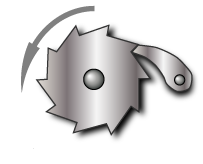
A clutch is a mechanical device that allows the output shaft to be disconnected from the rotating input shaft. The clutch's input shaft is typically attached to a motor, while the clutch's output shaft is connected to the mechanism that does the work.
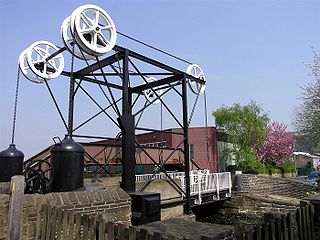
The windlass is an apparatus for moving heavy weights. Typically, a windlass consists of a horizontal cylinder (barrel), which is rotated by the turn of a crank or belt. A winch is affixed to one or both ends, and a cable or rope is wound around the winch, pulling a weight attached to the opposite end. The Greek scientist Archimedes was the inventor of the windlass. A surviving medieval windlass, dated to 1360-1400 is in the Church of St Mary and All Saints, Chesterfield. The oldest depiction of a windlass for raising water can be found in the Book of Agriculture published in 1313 by the Chinese official Wang Zhen of the Yuan Dynasty.

A winch is a mechanical device that is used to pull in or let out or otherwise adjust the tension of a rope or wire rope.

A ratchet is a mechanical device that allows continuous linear or rotary motion in only one direction while preventing motion in the opposite direction. Ratchets are widely used in machinery and tools. The word ratchet is also used informally to refer to a ratcheting socket wrench.
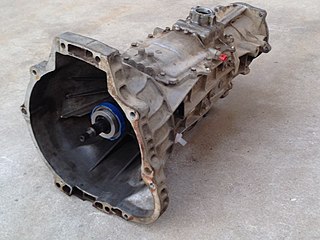
A manual transmission (MT), also known as manual gearbox, standard transmission, or stick shift, is a multi-speed motor vehicle transmission system, where gear changes require the driver to manually select the gears by operating a gear stick and clutch.

A parking pawl is a device fitted to a motor vehicle's automatic transmission that locks up the transmission when the transmission shift lever selector is placed in the Park position. "Park" is the first position of the lever in all cars sold in the United States since 1965 through SAE J915, and in most other vehicles worldwide.

In mechanical or automotive engineering, a freewheel or overrunning clutch is a device in a transmission that disengages the driveshaft from the driven shaft when the driven shaft rotates faster than the driveshaft. An overdrive is sometimes mistakenly called a freewheel, but is otherwise unrelated.

A breechblock is the part of the firearm action that closes the breech of a breech loading weapon before or at the moment of firing. It seals the breech and contains the pressure generated by the ignited propellant. Retracting the breechblock allows the chamber to be loaded with a cartridge.

A cable tie is a type of fastener for holding items together, primarily electrical cables and wires. Because of their low cost, ease of use, and binding strength, cable ties are ubiquitous, finding use in a wide range of other applications. Cable ties were first manufactured by Thomas & Betts under the brand name Ty-Rap.
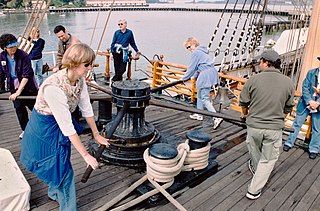
A capstan is a vertical-axled rotating machine developed for use on sailing ships to multiply the pulling force of seamen when hauling ropes, cables, and hawsers. The principle is similar to that of the windlass, which has a horizontal axle.

A latch or catch is a type of mechanical fastener that joins two objects or surfaces while allowing for their regular separation. A latch typically engages another piece of hardware on the other mounting surface. Depending upon the type and design of the latch, this engaged bit of hardware may be known as a keeper or strike.

A windlass is a machine used on ships that is used to let-out and heave-up equipment such as a ship's anchor or a fishing trawl. On some ships, it may be located in a specific room called the windlass room.

In road vehicles, the parking brake, also known as a handbrake or emergency brake (e-brake), is a mechanism used to keep the vehicle securely motionless when parked. Parking brakes often consist of a pulling mechanism attached to a cable which is connected to two wheel brakes. In most vehicles, the parking brake operates only on the rear wheels, which have reduced traction while braking. The mechanism may be a hand-operated lever, a straight pull handle located near the steering column, or a foot-operated pedal located with the other pedals.
The AXOD was a 4-speed automatic transaxle for transverse front wheel drive automobiles from the Ford Motor Company. It was introduced in the 1986 Ford Taurus/Mercury Sable. The AXOD and its successors are built in Ford's Van Dyke Transmission plant in Sterling Heights, Michigan. Production of the final member of the family, the 4F50N, ended in November 2006.
In horology, a maintaining power is a mechanism for keeping a clock or watch going while it is being wound.
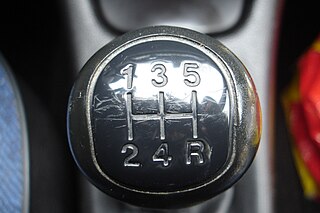
A gear stick, gear lever, gearshift or shifter, more formally known as a transmission lever, is a metal lever attached to the transmission of an automobile. The term gear stick mostly refers to the shift lever of a manual transmission, while in an automatic transmission, a similar lever is known as a gear selector. A gear stick will normally be used to change gear whilst depressing the clutch pedal with the left foot to disengage the engine from the drivetrain and wheels. Automatic transmission vehicles, including hydraulic automatic transmissions, automated manual and older semi-automatic transmissions, like VW Autostick, and those with continuously variable transmissions, do not require a physical clutch pedal.

The HK21 is a German 7.62 mm general-purpose machine gun, developed in 1961 by small arms manufacturer Heckler & Koch and based on the G3 battle rifle. The weapon is in use with the armed forces of several Asian, African and Latin American countries. It was also license-manufactured by Fábrica de Braço de Prata in Portugal as the m/968 and in Mexico by SEDENA as the MG21. In the German military (Bundeswehr) and the federal police (Bundespolizei) it is designated "G8".

A sequential manual transmission, also known as a sequential gearbox, or a sequential transmission, is a type of non-synchronous manual transmission used mostly for motorcycles and racing cars. It produces faster shift times than traditional synchronized manual transmissions, and restricts the driver to selecting either the next or previous gear, in a successive order.
In engineering, a dog is a tool or part of a tool, such as a pawl, that prevents or imparts movement through physical engagement. It may hold another object in place by blocking it, clamping it, or otherwise obstructing its movement. Or it may couple various parts together so that they move in unison – the primary example of this being a flexible drive to mate two shafts in order to transmit torque. Some devices use dog clutches to lock together two spinning components. In a manual transmission, the dog clutches, or "dogs" lock the selected gear to the shaft it rotates on. Unless the dog is engaged, the gear will simply freewheel on the shaft.

Shift-by-wire is an automotive concept or system that employs electrical or electronic connections that replace the mechanical connection between the driver's gearshift mechanism and the transmission. Since becoming commercially available in 1996, shift-by-wire has been commonly used in automated manual transmission and has later been implemented in semi-automatic transmission and automatic transmission.
